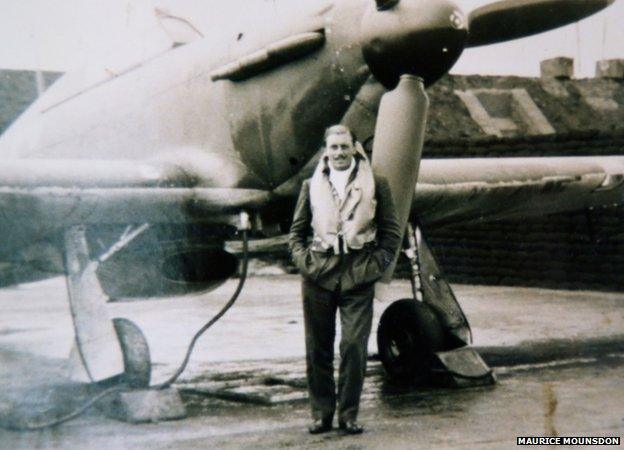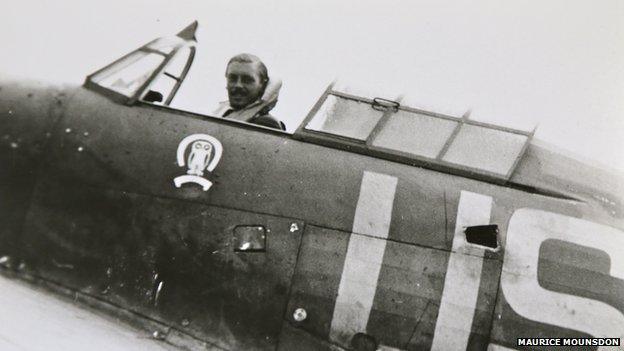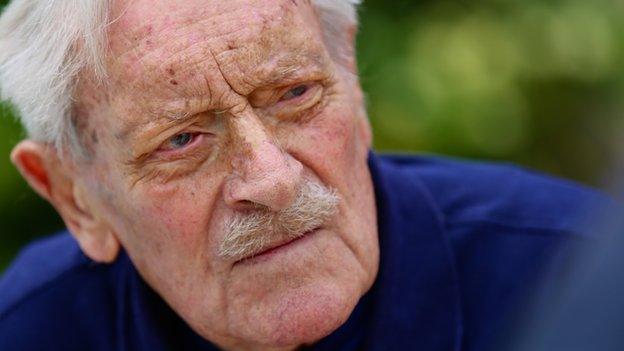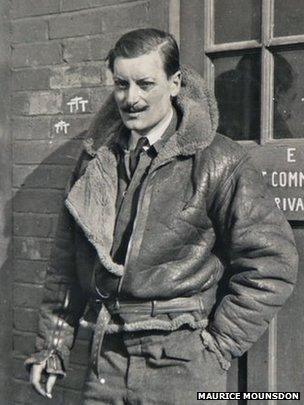The Battle of Britain pilot on fire when he learned to parachute
- Published

Maurice Mounsdon's flying helmet is housed in an Essex museum
Inside the Battle of Britain Room at North Weald Airfield Museum in Essex lies a flying helmet. It belonged to Maurice Mounsdon, whose wrecked aircraft was found burning in a neighbouring parish. He is one of just 26 RAF Battle of Britain pilots left to tell their tale on the 70th anniversary of VE Day.
"I was on fire. There was only one thing to do and that was to get out as fast as possible," he says.
His Hawker Hurricane had been hit in the gravity fuel tank just behind the dashboard by a German cannon shell.
"It exploded and blew petrol into the cockpit, which instantly caught fire," says Lichfield-born Mr Mounsdon, now 97.
As a 22-year-old pilot officer serving with 56 Squadron out of North Weald, he flew his last mission on 31 August 1940.

Maurice Mounsdon had never used a parachute before he was shot down by a German cannon shell
It was a Saturday morning and the sky was blue and bright.
"We were sent up to intercept some bombers," he said.
"They came down on us and I shot one of them. I came down to have another go somewhere over Colchester and I was hit.
"I was badly burned, but I rolled the aircraft over and came down by parachute from 14,000ft.
"I was conscious all the time. When you are in a situation like that the adrenalin kicks in and you know straight away what needs to be done: either stay in the aircraft and be dead, or get out and have a chance of staying alive. Simple as that.
"It was the first time I'd used a parachute. I think I was jolly lucky, in a way."

The downed Maurice Mounsdon was met by the Home Guard armed with pitch forks
As he drifted in the skies over the church tower at High Easter, his Hurricane spun out of control, scattering bullets onto the village below as the locals took cover.
His aircraft crashed and burned, and his discarded flying helmet was found in the next parish.
Mr Mounsdon landed in a field just behind the spot where High Easter's village hall now stands.
He was found with terrible burns to his legs and hands.
His descent had been tracked by villagers and the Home Guard arrived armed with pitch forks, fearing he might be a fallen foe.
"I was picked up by some local people," he says.
"First a young girl arrived, aged 10 or 12, and she had her younger sister with her. I think I said 'hello'. Then some men came and took me away by motor car.

After World War Two, Maurice Mounsdon taught others to fly
"I wasn't in pain at the time; I was in acute discomfort. The pain comes later. Burns are rather uncomfortable".
Mr Mounsdon was taken in by villagers and a local nurse cared for him until he was moved to Black Notley Hospital, which at the time specialised in plastic surgery.
A further two years in various hospitals would follow, including pioneering skin grafts at East Grinstead's Queen Victoria Hospital carried out by the founder of the so-called "Guinea Pig Club", Archibald McIndoe.
It was while in hospital that he married his childhood sweetheart Mary.
Mr Mounsdon went back to work first at North Weald and then onto RAF Cambridge where he became a flying instructor at Marshalls Airport teaching young men to fly Tiger Moths. He and Mary settled in Hertfordshire, later moving to Menorca.
"You just get over these things," he says of his crash.
"I joined the air force to fly, and I just wanted to get back in the air".